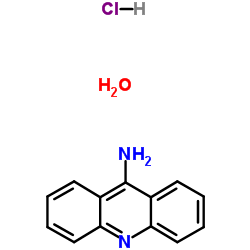9-Aminoacridine HCl H2O

9-Aminoacridine HCl H2O structure
|
Common Name | 9-Aminoacridine HCl H2O | ||
|---|---|---|---|---|
| CAS Number | 52417-22-8 | Molecular Weight | 248.708 | |
| Density | N/A | Boiling Point | 413.5ºC at 760 mmHg | |
| Molecular Formula | C13H13ClN2O | Melting Point | 300 °C(lit.) | |
| MSDS | Chinese USA | Flash Point | 233.2ºC | |
| Symbol |

GHS06 |
Signal Word | Danger | |
|
Acute toxicity and genotoxicity study of fermented traditional herb formula Guibi-tang.
J. Ethnopharmacol. 156 , 182-9, (2014) Guibi-tang (Guipi-tang in Chinese and Kihi-to in Japanese) is a multi-herb traditional medicine commonly prescribed to treat psychoneurosis in East Asia. Although this medicine has been widely used, there is little available information on the safety and toxi... |
|
|
Nucleic acid-mutagen interactions: crystal structure of adenylyl-3',5'-uridine plus 9-aminoacridine.
Nature 253 , 324, (1975)
|
|
|
Mutagenic assessment of olmesartan cilexetil by bacterial mutation assay.
Toxicol. Res. 29 , 217-9, (2014) Hypertension is a serious health problem due to high frequency and concomitant other diseases including cardiovascular and renal dysfunction. Olmesartan cilexetil is a new antihypertensive drug associated with angiotensin II receptor antagonist. This study wa... |
|
|
In Vitro and In Vivo Genotoxicity Assessment of Aristolochia manshuriensis Kom.
Evid. Based. Complement. Alternat. Med. 2012 , 412736, (2012) Arisolochiae species plants containing aristolochic acids I and II (AA I and AA II) are well known to cause aristolochic acid nephropathy (AAN). Recently, there are various approaches to use AAs-containing herbs after the removal of their toxic factors. Howev... |